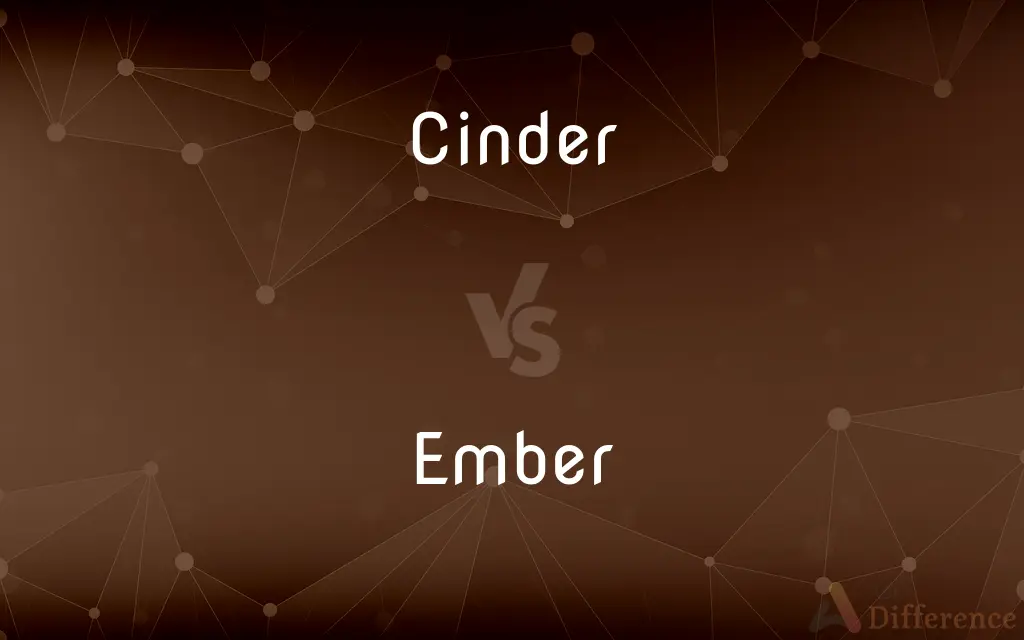Cinder vs. Ember — What's the Difference?
Cinder is a partially burnt coal or wood piece without flames, often industrial waste, while an ember is a glowing coal or wood from a dying fire, retaining heat and able to reignite.

Difference Between Cinder and Ember
Table of Contents
ADVERTISEMENT
Key Differences
Cinders are the byproducts of combustion, typically seen in industrial settings or from materials like coal that have been burnt but retain some unburned portions. These remnants are often considered waste and are characterized by their lightweight and porous nature, resulting from the escape of gases during combustion. On the other hand, embers are the glowing remains of wood or coal in a fire, holding onto heat long after flames have disappeared. They are often red or orange, indicating their high temperature, and are capable of reigniting with sufficient oxygen or fuel.
In terms of physical appearance, cinders are more likely to be gray and ashy, reflecting their status as combustion waste, whereas embers are identified by their incandescence, offering a visual cue to their latent heat. This distinction highlights their different stages in the combustion process and potential for further use or ignition. The formation of cinders implies a more complete combustion process, potentially leading to their disposal or repurposing, while the presence of embers suggests an ongoing process that might still transition back to active flaming with the right conditions.
Cinders and embers also differ in their handling and safety considerations. Due to their residual heat, embers can be a fire hazard if not properly managed, requiring careful attention when extinguishing fires or disposing of fire remnants. Cinders, being less associated with active combustion, pose different concerns, such as environmental impact if not disposed of properly, given their association with industrial waste.
In gardening or landscaping, cinders can be used for their lightweight and water-retentive properties, contributing to soil aeration and drainage. Embers, due to their heat, don't have a direct application in these settings but serve as a metaphor for persistence and potential, embodying the idea that even a small spark can lead to a renewed blaze under the right circumstances.
Comparison Chart
Definition
Partially burnt piece of coal or wood, often considered waste.
Glowing, hot coal or wood from a dying fire.
ADVERTISEMENT
Appearance
Gray, ashy, and porous.
Reddish, glowing with retained heat.
Combustion Stage
Post-combustion, with some material unburned.
Late stage of active combustion, capable of reigniting.
Uses
Construction aggregate, aeration in gardening.
Reigniting fires, warmth.
Safety Concerns
Environmental impact if not managed.
Fire hazard if not properly extinguished.
Symbolism
Often associated with waste or byproducts.
Symbolizes potential for renewal and continuity.
Compare with Definitions
Cinder
Burnt material that remains after a fire, especially from coal.
The furnace was filled with cinders after days of burning coal.
Ember
A small, glowing piece of coal or wood in a dying fire.
The campfire was reduced to embers by midnight, softly illuminating the campsite.
Cinder
Used in construction, especially in lightweight blocks.
Cinder blocks were chosen for the garden wall for their durability and light weight.
Ember
Can reignite into flame with enough air.
The gentle breeze stirred the embers into a small flame once again.
Cinder
Can be used for traction on icy roads.
The city spread cinders on the roads to improve traction after the snowstorm.
Ember
Symbolic of the last remains of something.
The fading traditions were like embers of a once vibrant culture.
Cinder
Associated with industrial waste.
The old factory site was littered with cinders from decades of production.
Ember
Retains heat for cooking or warmth after flames are gone.
They cooked the last of the marshmallows over the hot embers.
Cinder
Found in cinder cones, a type of volcanic formation.
The cinder cone had a distinctive shape, formed from layers of volcanic cinders.
Ember
Used metaphorically to describe a barely maintained state.
His hope was an ember, barely alive but still present.
Cinder
A cinder is a pyroclastic material. Cinders are extrusive igneous rocks; they are fragments of solidified lava.
Ember
An ember is a glowing, hot coal made of greatly heated wood, coal, or other carbon-based material that remain after, or sometimes precede, a fire. Embers can glow very hot, sometimes as hot as the fire which created them.
Cinder
A small piece of partly burnt coal or wood that has stopped giving off flames but still has combustible matter in it
A cold hearth full of cinders
Ember
A small piece of burning or glowing coal or wood in a dying fire
The dying embers in the grate
The flickering embers of nationalism
Cinder
Waste matter produced by smelting or refining ore; slag.
Ember
A small, glowing piece of coal or wood, as in a dying fire.
Cinder
A small piece of burned or partly burned substance, such as coal, that is not reduced to ashes but is incapable of further combustion.
Ember
Embers The smoldering coal or ash of a dying fire.
Cinder
A piece of charred substance that can burn further but without flame.
Ember
A glowing piece of coal or wood; a hot coal.
Cinder
Cinders Ashes.
Ember
Smoldering ash.
Cinder
Cinders(Geology) See scoria.
Ember
Making a circuit of the year or the seasons; recurring in each quarter of the year, as certain religious days set apart for fasting and prayer.
Ember fasts
Ember days
Ember weeks
Cinder
(Metallurgy) See scoria.
Ember
A lighted coal, smoldering amid ashes; - used chiefly in the plural, to signify mingled coals and ashes; the smoldering remains of a fire.
He takes a lighted ember out of the covered vessel.
Cinder
Slag from a metal furnace.
Ember
Making a circuit of the year of the seasons; recurring in each quarter of the year; as, ember fasts.
Cinder
To burn or reduce to cinders.
Ember
A hot glowing or smouldering fragment of wood or coal left from a fire
Cinder
Partially or mostly burnt material that results from incomplete combustion of coal or wood etc.
Cinder
An ember.
Cinder
Slag from a metal furnace.
Cinder
Any strong stimulant added to tea, soda water, etc.
Cinder
(transitive) To reduce to cinders.
Cinder
(transitive) To cover with cinders.
We plan to cinder this path.
Cinder
Partly burned or vitrified coal, or other combustible, in which fire is extinct.
Cinder
A hot coal without flame; an ember.
Cinder
A scale thrown off in forging metal.
Cinder
The slag of a furnace, or scoriaceous lava from a volcano.
Cinder
A fragment of incombustible matter left after a wood or coal or charcoal fire
Common Curiosities
Are cinders only produced from coal?
While coal is a common source, cinders can come from any partially burnt material, including wood and other combustibles, especially in industrial contexts.
Can cinders be recycled or repurposed?
Yes, cinders can be used in construction, as lightweight aggregates, or in gardening for soil aeration and water retention.
Can cinders be reignited like embers?
Generally, cinders are less likely to reignite compared to embers because they are more burnt out and contain less combustible material.
Do embers produce smoke?
Embers can produce minimal smoke as they are in the late stages of combustion, but they primarily emit heat and a soft glow.
Can cinders from volcanic eruptions be dangerous?
Yes, volcanic cinders can be sharp and hazardous, and when airborne, they pose risks to respiratory health and aviation.
How do you safely handle embers?
Embers should be fully extinguished with water or sand and monitored to ensure they do not reignite, as they can remain hot for hours.
What makes embers glow?
The glow of embers comes from the heat of their remaining combustion, emitting light in the visible spectrum as they continue to oxidize at a slow rate.
How long can embers stay hot?
Embers can retain heat for several hours, depending on their size, the material they're made from, and environmental conditions.
Is there a specific way to distinguish cinders from embers at a glance?
Typically, cinders are ashier and less likely to glow, whereas embers retain a noticeable glow and warmth, indicating ongoing combustion.
Are embers a fire hazard?
Yes, embers can be a significant fire hazard if not properly managed, as they can easily ignite nearby flammable materials.
Share Your Discovery

Previous Comparison
Fleabag vs. Hotel
Next Comparison
Asafoetida vs. Fetid














































